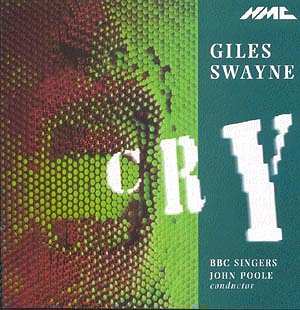Giles Swayne: Havoc BBC Proms Royal Albert Hall 8 September 1999
Robin Tyson, counter-tenor Philippa Davies, flute Alison Smart & Carolyn Foulkes, sopranos Kim Porter, contralto Andrew Murgatroyd, tenor BBC Singers Endymion Ensemble Stephen Cleobury, conductor
When CRY appeared in 1980, Giles Swayne's imaginative combination of extended vocal techniques and African-derived melodic patterns was a radical shock to a British music scene still in transition from the post-war avant-garde. Havoc is the long planned sequel, and it is to Swayne's credit that he has not repeated himself. In subject matter and conception, this is very much a work for the late '90s.
The physical dimensions of Havoc are also appreciably different. To the nucleus of CRY's 28 voices are added a counter-tenor and continuo group, three solo female voices and a 23-piece ensemble featuring evocative percussion writing. All except the orchestra are electronically treated subtly and effectively, in ways that the Albert Hall acoustic comes into its own.
There are five movements, charting the 'fall' of humankind from its recent technological zenith of 'Journey into Space' - through the relentless pollution and deforestation of the 'Delicate Machines' of our environment; then the inevitable exhaustion of natural resources - 'Out of Air' - and descent 'Into Darkness'. The outcome is a dark and empty 'Nothing', the black hole to which we may be close to condemning ourselves. Swayne prefaces each of these movements with a prologue in which the counter-tenor, with attendant continuo, addresses listeners as an 'id' as against the 'mass' of the chorus - their undifferentiated responses highlighted by the decreasing number of solo singers who represent them.
It is here that problems arise. Each of the movements decreases in length and gains in intensity, while the prologues increase and assume greater gravity within their immediate context. Yet Swayne's material is insufficiently varied, in content or treatment, to enhance the dramatic polarity that this proportional change requires. There's little of the textural or musical focus that made CRY so compelling over a comparable span. This lack of focus makes Havoc seem a more provisional work; its clean but featureless vocal writing, of a text which offsets extracts from Sophocles's Antigone with colloquialisms long ago reduced to cliché, gives the whole a dated rather than timeless feel.

It would be a pity if the work were not to prove more durable. Swayne is
a powerful communicator: some judicious cuts in the sequences of the second
and third movements may help to give Havoc's currently 75 minutes greater
overall momentum: like Birtwistle, Swayne occasionally lets his formal plans
get the better of his musical instincts. For now, do investigate the BBC
Singers' magnetic 1984 recording of CRY - on
NMC
D016 - and their collection of shorter choral works - Collins Classics
15312
- including the powerful Missa Tiburtina, the forerunner of Havoc in
several respects. Whatever the reservations about Havoc, its sincerity and
scope are not so frequently encountered in new music these days as to be
other than welcome.
Reviewer
Richard Whitehouse
 Return to:
Return to: